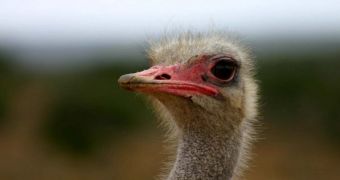Researchers have recently set forth a very bold new idea on why large flightless birds such as the ostrich lost their ability to fly. The hypothesis holds that, as the dinosaurs went extinct during the K-T event, more than 65 million years ago, they left behind an open niche, which these animals occupied. And, according to the idea, they continue to occupy it to this very day. Foraging on the ground was one of the abilities that ostriches took over from dinosaurs. Another one was growing larger with each generation, and so eventually these animals lost their ability to fly, LiveScience reports.
An old theory had it that many flightless birds that make up the ratite group, had the same flightless ancestor. These animals include African ostriches, Australasian emus, kiwis and cassowaries, South American rheas, and the extinct New Zealand moa birds. “Ratite birds have been thought of as relics of the former Gondwanan supercontinent, which combined Africa, South America, Australia, Antarctica, New Zealand, India and Madagascar,” explains Australian National University in Canberra evolutionary biologist and researcher, Matthew Phillips. The issue with that was how did the ancestors manage to cross the vast distances separating all the world's continents.
Since 2008, geneticists have argued that all these birds indeed shared an ancestor in common, but proposed that the ancestor was not flightless. Their idea was established as accurate in a new set of investigations. “Various ideas about hopping between temporary islands and now-sunken micro-continents are no longer necessary – the ancestors of all these birds could simply have flown,” Phillips reveals. “I was analyzing DNA sequences for some of these ratites and kept coming up with the 'wrong' answers, which I ignored for a while, before doing the analyses more thoroughly and realizing that in fact, the evolutionary history of these birds was not how I and others had imagined it to be,” he adds.
One possible reason for why birds that followed lost their ability to fly could be the fact that they no longer needed it. As the researchers explained, for as long as there were dinosaurs, there was an imperative need for the ratites to keep airborne, so as not to become the meal. As the giant lizards vanished, the birds started spending more and more time on the ground, safe from predators. Hence, they renounced flying, as a habit that required a lot of energy on their part, and also limited their size.

 14 DAY TRIAL //
14 DAY TRIAL //